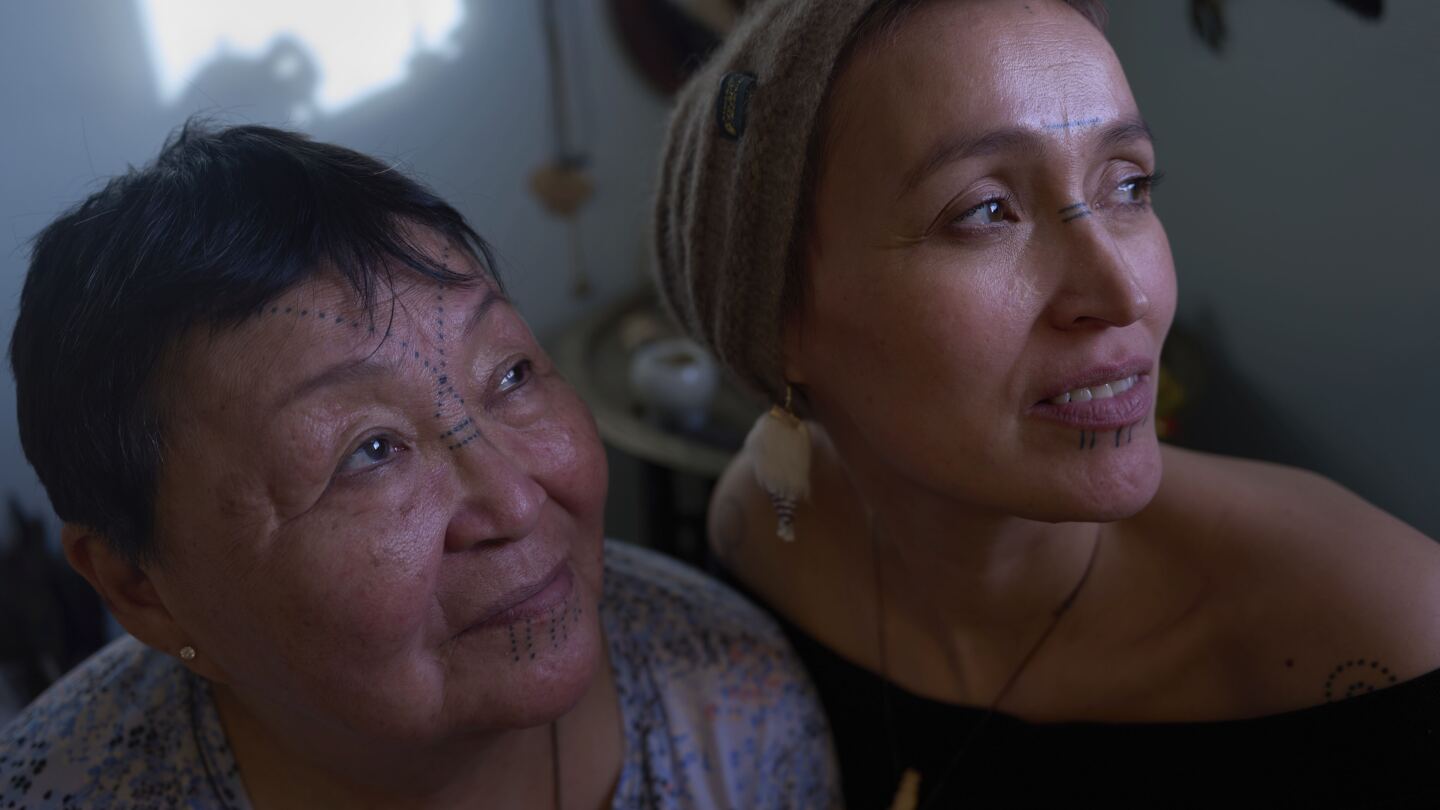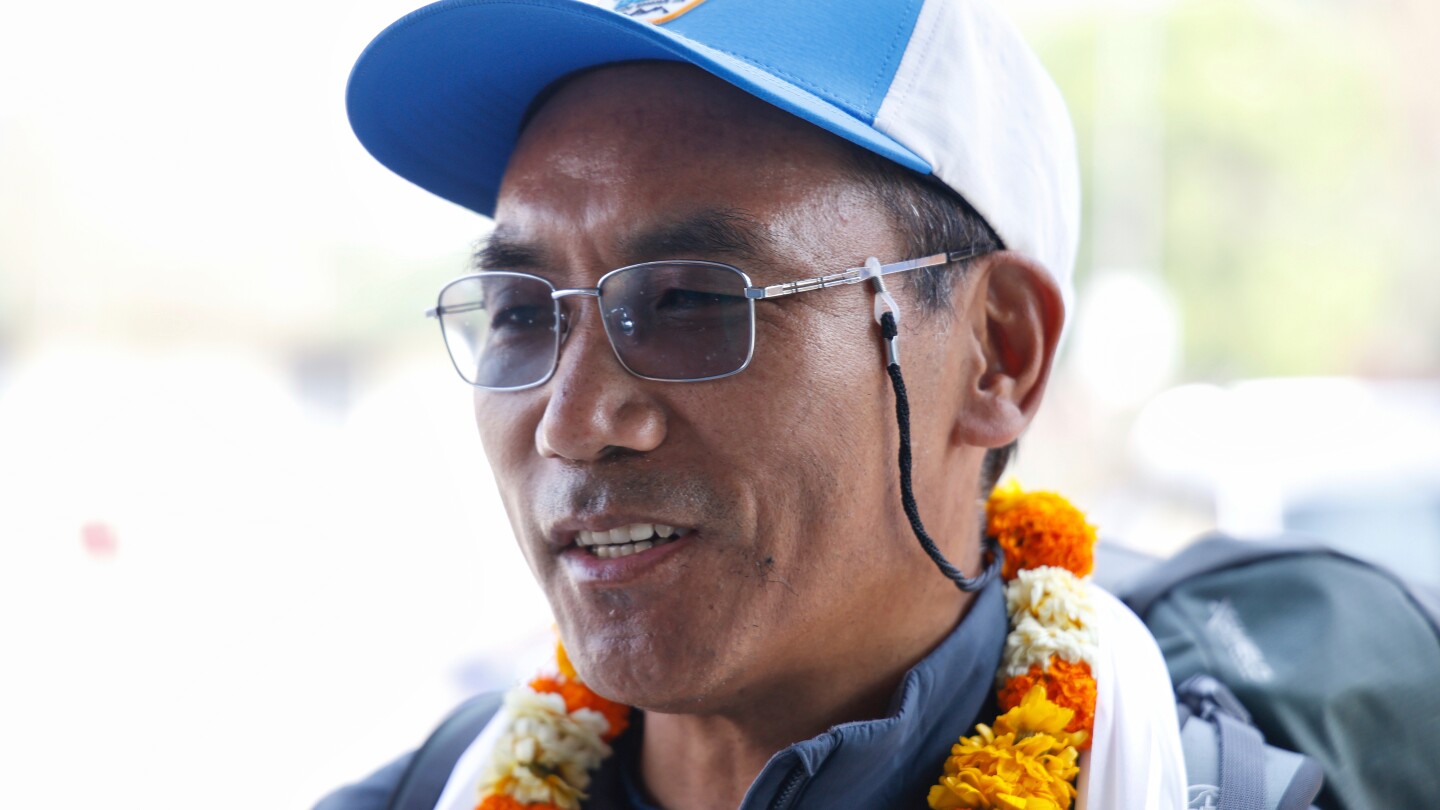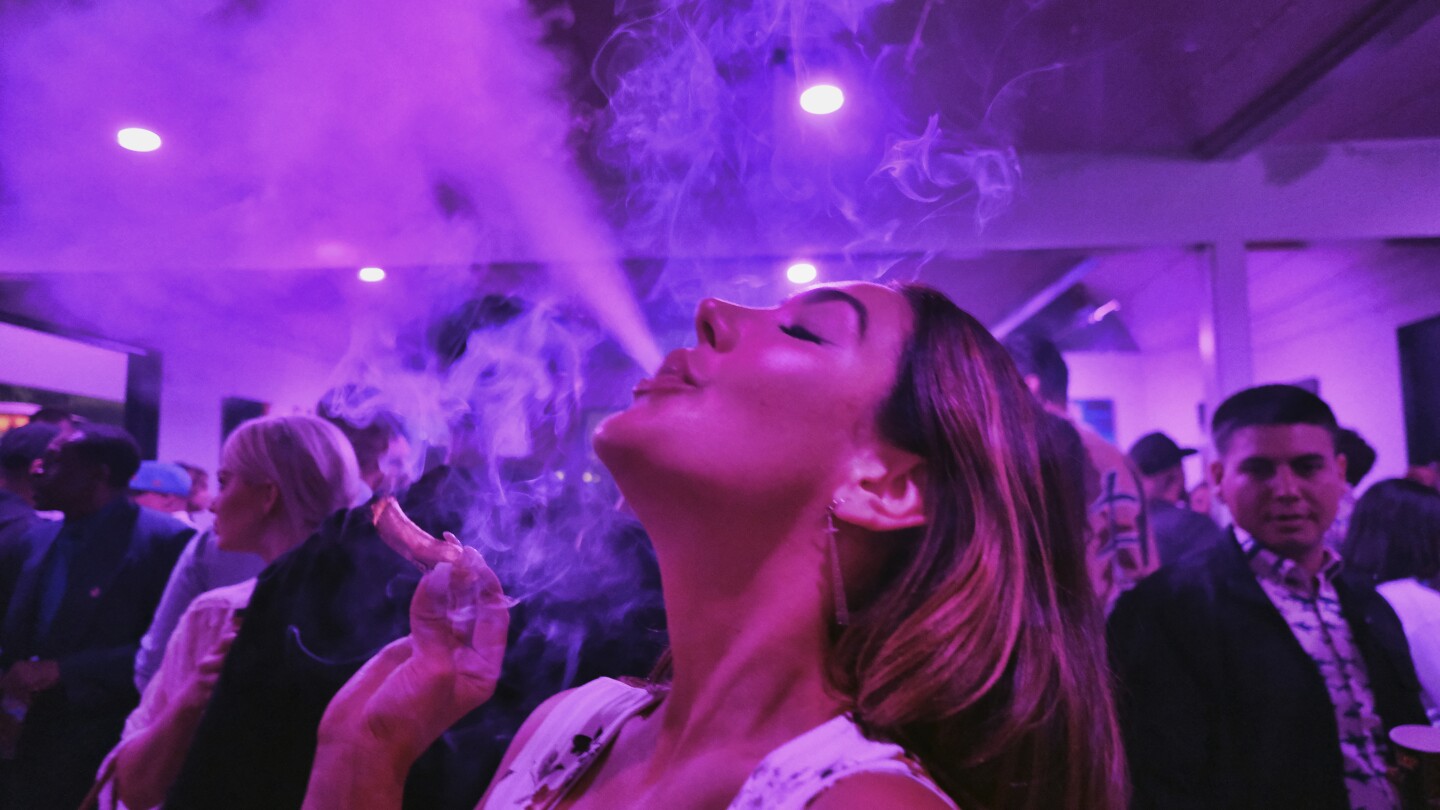Lifestyle
How Greenlanders embrace Inuit traditions to reclaim their roots

NUUK, Greenland (AP) — Sitting on the pelt of a polar bear hunted by her family, Aviaja Rakel Sanimuinaq says she’s proud to be part of a movement of Greenlanders reclaiming their Inuit traditions and spirituality.
The shaman, who has Inuit facial tattoos, works with spiritual healing practices to help people connect with their ancestors and heal generational trauma. A sign outside her studio in the Greenland capital of Nuuk conveys her role: “Ancient knowledge in a modern world.”
Shaman Aviaja Rakel Sanimuinaq lies on the pelt of a polar bear her family hunted and is now kept in a studio where she performs Inuit ancestral spiritual healing in Nuuk, Greenland, on Wednesday, Feb. 19, 2025. (AP Photo/Luis Andres Henao)
In recent years, Greenlanders like her have been embracing pre-Christian Inuit traditions, including drum dancing and Inuit tattoos. For some, it’s a way to proudly reclaim their ancestral roots. It’s also a way to reject the legacy of European Christian missionaries who colonized Greenland in the 18th century and suppressed their traditions, labeling them as pagan.
“The sacredness of Christianity is still sacred in my eyes. But so is Buddhism, so is Hinduism, and so is my work,” Sanimuinaq said in her studio, surrounded by skulls of seals, raven feathers and medicinal herbs. They help the “angakkoq,” or shaman, communicate with “silam aappaa” or the other world — the spiritual world.
“That’s where I stand – that the arising of our culture, and us as a people, is also to get the equality within our culture, to acknowledge that our culture is legit; that it has to have a space here.”
The Inuit have survived and thrived for generations in one of the most remote, vast and rugged places on Earth, hunting for seals, whales and polar bears. Their traditional religion is animist.
Inuit believe that “every animal and bird, every stone and every piece of earth, the rain and the snow all have a spirit and a right to be respected,” authors Gill and Alistair Campbell write in their travel book, “Greenland.”
Aviaja Rakel Sanimuinaq, an angakkoq or shaman, poses for a portrait where she performs soul healing in Nuuk, Greenland, on Wednesday, Feb. 19, 2025. (AP Photo/Luis Andres Henao)
About 90% of the 57,000 Greenlanders identify as Inuit and the vast majority belong to the Lutheran Church. A Danish missionary brought that branch of Christianity to the world’s largest island more than 300 years ago.
Greenland is now a semi-autonomous territory of Denmark, and Greenlanders increasingly favor getting full independence — a crucial issue in a recent parliamentary election.
Some say Greenland’s independence movement received a boost after U.S. President Donald Trump pushed their Arctic homeland into the spotlight by threatening to take it over.
Shaman Aviaja Rakel Sanimuinaq places her hand on the paw of a polar bear that her family hunted and that is now at a studio where she performs Inuit ancestral spiritual healing in Nuuk, Greenland, on Wednesday, Feb. 19, 2025. (AP Photo/Luis Andres Henao)
“We don’t have to walk silenced anymore,” Sanimuinaq said. “That’s the change we see — that the voice we get out in the world has been forbidden even within our country. Now that we’re opening, we have more freedom.”
The spiritual and social value of Tunniit — the traditional Inuit tattoos
The suppression of Inuit drums and facial tattoos were part of a broader effort to Christianize and assimilate Inuit into the European way of life, said Asta Mønsted, a professor at the University of California, Berkeley. She researches Inuit oral history and its connections to Greenland’s archaeology.
“Drum songs and drum duels were central to Inuit spiritual and social life, but the missionaries viewed them as pagan practices and superstitions that needed to be replaced with Christian hymns and prayers,” she said. “Drums were confiscated or destroyed in order to break the connection to the pre-Christian beliefs.”
In some parts of Greenland, though, the drum songs and knowledge of drum-making were preserved without the church’s knowledge.
“Tattoos were also linked to Inuit cosmology and rites, but missionaries labeled them as pagan and especially viewed the facial tattoos as a defilement of God’s creation,” said Mønsted. “They promoted the European ideal, where the human body should remain unmarked.”
Aviaja Rakel Sanimuinaq, an angakkoq or shaman, poses for a portrait where she performs soul healing in Nuuk, Greenland, on Wednesday, Feb. 19, 2025. (AP Photo/Luis Andres Henao)
Wearing Inuit facial tattoos, Shaman mother and daughter, Therecie Sanimuinaq Pedersen, left, and Aviaja Rakel Sanimuinaq, pose for a portrait at Aviaja’s studio where she performs Inuit ancestral spiritual healing in Nuuk, Greenland, on Wednesday, Feb. 19, 2025. (AP Photo/Luis Andres Henao)
“Tunniit,” the traditional Inuit tattoos, were etched by poking sod from soapstone lamps onto the skin with a needle or by dragging a sod-covered sinew thread underneath the skin.
Women generally got tattoos as they experienced menstruation and childbirth, viewing them as protection against illness and malevolent spirits, Mønsted said.
But resistance to Inuit tattoos deterred many Greenlanders across generations from getting them; some who had tattoos hid them, fearing repercussions.
Growing up, Therecie Sanimuinaq Pedersen recalled how her grandmother covered her facial tattoos in soot because she didn’t want to be alienated from her community.
Therecie only got the tattoos that now cover her face — the way she remembered her grandmother’s — after her daughter, Aviaja, got them in recent years.
“The tattoos I have goes from mother to daughter for thousands of years,” Therecie said in Greenlandic, translated by her daughter. “I have the same as my grandmother — that’s my heritage.”
These days, when she’s out on Nuuk’s streets and encounters others displaying Inuit tattoos, she feels encouraged, especially when she sees them on young Greenlanders.
“When I see them, it’s like we have a connection,” she said. “Without knowing them, and them knowing me, we say hi. Some come, give a hug, and say thank you.”
Inuit drum for conflict resolution and restoring pride in ancestral tradition
For the Inuit, the “qilaat” played a crucial role in conflict resolution through drum duels.
The drum, Mønsted said, had three main functions: for entertainment and socializing, as a tool for the shaman during their seances, and as part of a pre-colonial juridical system.
“In the drum duels, opponents used songs, insults, and exaggerated body movements to argue their case before the community, which would stand in a circle ar ound them,” Mønsted said.
She said the crowd’s collective laughter often determined the winner without the need for a formal ruling.
While some duels helped ease tensions, others ended in public humiliation, sometimes forcing the losing party to leave the community and become a “qivittoq” — a person living in nature outside of society. This exile could be tantamount to a death sentence in the frigid Arctic environment.
Greenland was a colony under Denmark’s crown until 1953, when it became a province in the Scandinavian country. In 1979, the island was granted home rule, and 30 years ago became a self-governing entity. But Denmark retains control over foreign and defense affairs.
The former colonial ruler is accused of committing abuses against Greenland’s Inuit, including removing children from their families in the 1950s with the excuse of integrating them into Danish society and fitting women with intrauterine contraceptive devices in the 1960s and 1970s — allegedly to limit population growth.
Some Greenlanders believe the recent global attention on their mineral-rich country and a unified call for independence from Denmark has allowed them to speak more openly about abuses committed by their former colonial ruler. Some have grown closer to their rich pre-Christian Indigenous culture.
“Our culture is very spiritual … I want to bring that back,” said Naja Parnuuna, an award-winning singer-songwriter.
“I want to be in that wave with my fellow young people… I feel like we’ve been looked down for so long, and we really haven’t had a voice for a long time.”
Growing up, she said she felt that it was “cooler to be a Dane, or to speak Danish, and was ashamed to be Greenlandic and follow Inuit traditions. “Maybe not embarrassing,” she said, “but it was taboo or weird to do the drums or be Inuk.”
Her father, Markus Olsen, is a former Lutheran pastor who was dismissed from his church position in 2022 after he allowed drum dancing during a National Day service at the Nuuk Cathedral. He knew that was risky but did it because he believes the quilaat, the Inuit traditional drum, needs to be reinstated into its valued position in religious services and other aspects of Greenlandic life.
Olsen, who wears a collar with a small qilaat and a crucifix, takes inspiration from the Latin American Liberation Theology movement, which holds that the teachings of Jesus require followers to fight for economic and social justice. He also takes inspiration from the Rastafari legend Bob Marley, the Rev. Martin Luther King Jr. and civil rights activist Malcolm X.
Parnuuna feels inspired by her father. She began to embrace her roots through her music, which encourages Greenlanders to value their Inuit culture and history.
“The more I practiced my art, singing and writing songs, I began to realize how important it is to accept … my roots, to have more self-respect, to have higher self-esteem and in that way have a healthier way of living and a more positive view of the world,” she said.
“It’s important to bring that back, so that we can love ourselves again.”
___
Associated Press religion coverage receives support through the AP’s collaboration with The Conversation US, with funding from Lilly Endowment Inc. The AP is solely responsible for this content.
Lifestyle
Queen Elizabeth II’s favorite dog breed race for glory in the UK’s Corgi Derby

LONDON (AP) — Some of the fastest canines on four very short legs have raced for glory in Scotland’s annual Corgi Derby.
The Musselburgh Racecourse Corgi Derby was first held in 2022 to mark Queen Elizabeth II’s 70 years on the throne. The late monarch was a devoted corgi fan who owned almost 30 of the breed over the decades, along with a few dorgis – a corgi-dachshund cross.
Four-year-old Juno beat a 16-strong field of dashing dogs dressed in bright sweaters over the 230-foot (70-meter) race on Saturday at the racecourse outside Edinburgh. She came from behind in the final stretch to beat last year’s winner, Rodney.
The winner and her owners, Alisdair Tew and Fran Brandon, were presented with a trophy and dog treats by tennis coach Judy Murray, mother of Scottish star Andy Murray.
Tew told the BBC that “we trained her for this last year but this year we just resorted to just letting her chasing things, particularly seagulls” on Edinburgh’s Portobello Beach.
“Juno is always ready for treats -– that is probably why she won,” he said.
Elizabeth’s love of corgis began in 1933 when her father, King George VI, brought home a Pembroke Welsh corgi they named Dookie
Corgis were often by Elizabeth’s side in the decades before her death in September 2022 — accompanying her on official tours, reportedly sleeping in their own room at Buckingham Palace and occasionally nipping the ankles of visitors or royal family members.
Three corgis even appeared alongside the queen as she climbed into James Bond’s waiting helicopter in the spoof video that opened the 2012 London Olympics.
Lifestyle
Famed Sherpa guide will attempt to climb Mount Everest for a 31st time and break his own record

KATHMANDU, Nepal (AP) — One of the greatest mountain guides will attempt to scale the world’s highest peak for the 31st time — and possibly the 32nd time as well — and break his own record.
Kami Rita, 55, flew to Mount Everest on Sunday from Kathmandu to lead a group of climbers who will try to reach the 8,849-meter (29,032-foot) summit during the spring climbing season.
“I am mentally, emotionally and physically prepared to climb the mountain,” Kami Rita told The Associated Press at Kathmandu’s airport. “I am in my top physical condition right now.”
He holds the record for the most successful ascents of Mount Everest at 30 times. In May last year he climbed the peak twice.
“My first priority is to get my client to the summit of the peak. Then I will decide on whether I will climb the peak more than one time during the season. It depends on the weather and conditions on the mountain,” he said.
His closest competitor for the most climbs of Mount Everest is fellow Sherpa guide Pasang Dawa, who has made 27 successful ascents of the mountain.
Kami Rita first climbed Everest in 1994 and has been making the trip nearly every year since. He is one of many Sherpa guides whose expertise and skills are vital to the safety and success each year of foreign climbers aspiring to stand on top of the mountain.
His father was among the first Sherpa mountain guides. In addition to his Everest climbs, Kami Rita has scaled several other peaks that are among the world’s highest, including K2, Cho Oyu, Manaslu and Lhotse.
According to Nepal’s Department of Tourism, 214 climbers have been issued permits to attempt Mount Everest from the Nepali side of the peak in the south this climbing season, which ends in May. Most climbing of Everest and nearby Himalayan peaks is done in April and May, when weather conditions are most favorable.
Everest was first climbed in 1953 by New Zealander Edmund Hillary and Nepali Sherpa Tenzing Norgay.
Lifestyle
Marijuana holiday 4/20 coincides with Easter and Passover this year. Here’s what to know

Marijuana culture’s high holiday, known as 4/20, falls this year on Easter Sunday, as well as the last day of Passover, meaning cannabis fans can celebrate in some unusual ways, including an “Easter nug hunt” in Los Angeles, kosher-style THC gummies in New York and a “blaze and praise” drag brunch in Portland, Oregon.
“It seemed appropriate with egg prices today that we’d be searching for something else,” said Brett Davis, who runs the marijuana tour company Weed Bus Los Angeles and organized the “Easter nug hunt.”
Here’s a look at 4/20’s history and how it’s being celebrated this year:
Why 4/20?
The origins of the date, and the term “420” generally, were long murky.
Some claimed it referred to a police code for marijuana possession or was derived from Bob Dylan’s “Rainy Day Women No. 12 & 35,” with its refrain of “Everybody must get stoned,” 420 being the product of 12 times 35.
But the prevailing explanation is that it started in the 1970s with a group of bell-bottomed buddies from San Rafael High School, in California’s Marin County north of San Francisco, who called themselves “the Waldos.”
A friend’s brother was afraid of getting busted for a patch of cannabis he was growing in the woods at nearby Point Reyes, so he drew a map and gave the teens permission to harvest the crop, the story goes.
During fall 1971, at 4:20 p.m., just after classes and football practice, the group would meet up at the school’s statue of chemist Louis Pasteur, smoke a joint and head out to search for the weed patch. They never did find it, but their private lexicon — “420 Louie” and later just “420” — would take on a life of its own.
The Waldos saved postmarked letters and other artifacts from the 1970s referencing “420,” which they now keep in a bank vault, and when the Oxford English Dictionary added the term in 2017, it cited some of those documents as the earliest recorded uses.
How did 4/20 spread?
A brother of one of the Waldos was a close friend of Grateful Dead bassist Phil Lesh, as Lesh once confirmed in an interview with the Huffington Post, now HuffPost. The Waldos began hanging out in the band’s circle, and the slang term spread.
Fast-forward to the early 1990s: Steve Bloom, a reporter for the cannabis magazine High Times, was at a Dead show when he was handed a flyer urging people to “meet at 4:20 on 4/20 for 420-ing in Marin County at the Bolinas Ridge sunset spot on Mt. Tamalpais.” High Times published it.
“It’s a phenomenon,” one of the Waldos, Steve Capper, now 69, once told The Associated Press. “Most things die within a couple years, but this just goes on and on. It’s not like someday somebody’s going to say, ‘OK, Cannabis New Year’s is on June 23rd now.’”
While the Waldos came up with the term, the people who made the flier that was distributed at the Dead show — effectively turning 4/20 into a holiday — remain unknown.
How is it celebrated?
With weed, naturally.
In New York City, the cannabis brand Tokin’ Jew is advertising a kosher-style THC gummy line, “Tokin’ Chews,” designed to meet dietary restrictions for Passover.
Davis said he expected 300 people to partake in the West Hollywood Easter nug scavenger hunt this weekend, aided by a mobile app leading them through participating dispensaries, trivia challenges and “stoner activities.” There is a $500 cash prize.
In Portland, Bar Carlo is hosting the “blaze and praise” drag brunch. Cannabis consumption isn’t allowed onsite — “Please blaze before you arrive or go for a walk in the neighborhood in between performances,” the event listing reads — but there will be a door-prize gift basket from a local dispensary.
Bar owner Melinda Archuleta said the brunch is a dry run for hosting Pride month events in June. She herself doesn’t care much for marijuana, but as a Mexican American who has been influenced by Catholicism, she is interested in seeing the two cultures melded “in a cheeky way.”
“I’m really looking forward to seeing how the queens do it,” Archuleta said. “We’ve obviously given them carte blanche to do whatever they want — it’s 21 and up — so it doesn’t matter if it’s sacrilegious or borderline offensive.”
There are bigger celebrations, too, including the Mile High 420 Festival in Denver and one put on by SweetWater Brewing in Atlanta. Hippie Hill in San Francisco’s Golden Gate Park historically has attracted massive crowds, but the gathering was canceled for a second straight year, with organizers citing a lack of financial sponsorship and city budget cuts.
Just north of the Bay Area, Lagunitas Brewing in Petaluma, California, releases its “Waldos’ Special Ale” every year on 4/20 in partnership with the term’s coiners.
4/20 also has become a big industry event, with vendors gathering to try each other’s wares.
What about the politics?
There are 24 states that allow recreational marijuana and 14 others allowing it for medical purposes. But the movement recently has suffered some setbacks, with voters in Florida, North Dakota and South Dakota deciding not to adopt legalization measures last November.
Several states also have cracked down on intoxicating products derived from hemp, which have been widely sold even in prohibition states thanks to a loophole in the federal Farm Bill.
Marijuana remains illegal under federal law. As a candidate, President Donald Trump said he would vote for Florida’s amendment and signaled support for reclassifying marijuana as a less dangerous drug, a process started by the Biden administration.
But his administration has not indicated cannabis policy is a priority. A fact sheet released by the White House last month complained that marijuana decriminalization in Washington, D.C., was an example of “failed policies” that “opened the door to disorder.”
A bipartisan group of senators last week reintroduced legislation that would ensure states can adopt their own cannabis policies and remove certain financial hurdles for the industry, such as letting entities deduct business expenses on their taxes.
Charles Alovisetti, a lawyer with the cannabis industry law firm Vicente LLP, said he hopes the administration will push forward with marijuana reform at the federal level, saying “it does align with some of their policy objectives — namely reducing criminal activity, or cartel activity.”
He also encouraged advocates to keep pushing, noting some measures such as improving banking access for marijuana businesses might pass as part of larger legislative packages.
“You continue speaking up, even if the political momentum isn’t there,” Alovisetti said. “It’s only possible if you stay in everyone’s ear.”
-

 Education2 days ago
Education2 days agoHarvard’s battle with the Trump administration is creating a thorny financial situation
-

 Sports2 days ago
Sports2 days agoClint Dempsey speaks to CNN over his concerns over the USMNT heading into its home World Cup
-

 Europe2 days ago
Europe2 days agoTrump’s ‘lone ranger’: How Steve Witkoff became the defacto point man on America’s foreign policy challenges
-

 Conflict Zones2 days ago
Conflict Zones2 days agoIran has ‘doubts’ about US intentions ahead of nuclear talks | Politics News
-

 Middle East1 day ago
Middle East1 day agoTunisian court hands opposition figures lengthy jail terms | Human Rights News
-

 Conflict Zones2 days ago
Conflict Zones2 days ago‘How do I live like this?’ asks Gaza boy who lost arms in Israeli attack | Gaza News
-

 Conflict Zones2 days ago
Conflict Zones2 days agoTrump says US may ‘pass’ on helping end war if Russia, Ukraine resist deal | Russia-Ukraine war News
-

 Europe1 day ago
Europe1 day agoVance, Vatican officials engage in ‘exchange of opinions’ over migrants




